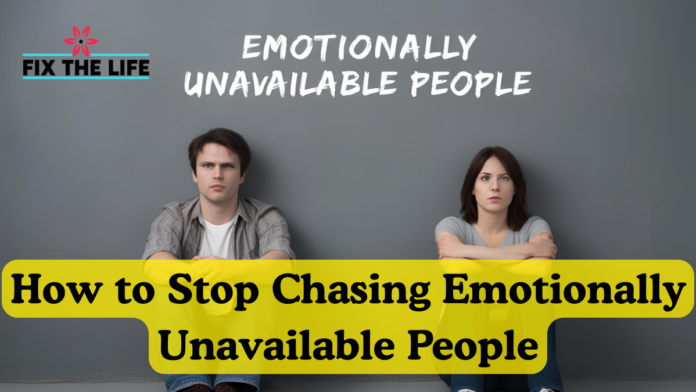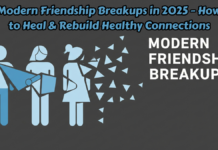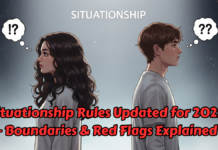If you’ve ever felt stuck in a cycle of chasing love from someone who can’t fully commit, you’re not alone. Many individuals find themselves attracted to emotionally unavailable people, hoping to break through their walls or prove their worth. Unfortunately, this pattern often leads to disappointment, self-doubt, and unfulfilled emotional needs.
Healing begins with self-awareness, understanding attachment wounds, and actively working toward self-worth healing. This guide explores the psychology behind chasing unavailable partners and provides strategies to break free from this cycle.
Chasing unavailable people isn’t about the person—it’s about deep-seated emotional patterns that shape our relationship choices.
Common Psychological Reasons:
- Attachment Wounds from Childhood – Early emotional neglect can create a subconscious desire to “earn” love.
- Fear of Intimacy – Some individuals chase unavailable partners to avoid true vulnerability.
- Low Self-Worth – Believing one must “prove” their value by making someone commit.
- Familiarity with Chaos – If unpredictable love feels normal, stable affection might seem uncomfortable.
- Idealizing the “Fixer” Role – Some find purpose in trying to heal emotionally distant people.
Understanding the root cause of this pattern is the first step toward breaking free.
If your relationship involves any of the following behaviors, your partner may be emotionally detached:
1. They Avoid Deep Conversations
They dodge emotional topics, downplay feelings, or redirect conversations when intimacy arises.
2. Mixed Signals & Hot-and-Cold Behavior
One day they’re affectionate; the next, they pull away, leaving you confused.
3. They Struggle With Commitment
They avoid labels, future discussions, or anything that suggests long-term involvement.
4. They Prioritize Independence Over Connection
Their focus is on personal freedom rather than emotional investment in the relationship.
5. You Feel Like You’re Always Chasing Them
If you’re doing all the emotional work, initiating contact, or adjusting expectations to accommodate them, this dynamic is draining.
Recognizing these signs helps shift focus toward healthy relational choices.
How to Break the Cycle & Reclaim Emotional Power
Breaking free from chasing unavailable people requires internal healing, boundary-setting, and redefining self-worth.
1. Heal Your Attachment Wounds
Self-reflection uncovers unconscious patterns driving your attraction to unavailable partners.
How to Start:
- Journaling about past relationships and childhood experiences.
- Identifying patterns in your attachment style (e.g., anxious attachment).
- Seeking therapy or resources for emotional healing.
When you address attachment wounds, relationship patterns begin to change.
2. Shift Your Definition of Love
Love isn’t something to earn, prove, or chase—it’s something that should naturally flow between two willing individuals.
Mindset Changes:
- Healthy relationships feel secure, not anxiety-driven.
- Love shouldn’t feel like emotional labor.
- The right person will meet you halfway, instead of keeping you in pursuit.
When you accept that love doesn’t require chasing, you allow healthier connections to form.
3. Set Firm Emotional Boundaries
Chasing unavailable partners often results from weak boundaries and ignoring red flags.
How to Create Boundaries:
- Stop initiating conversations if effort isn’t mutual.
- Identify behaviors that make you feel unimportant or drained.
- Say no to connections that don’t align with your emotional needs.
Boundaries ensure self-respect comes before attachment.
4. Rebuild Self-Worth & Emotional Resilience
Attraction to unavailable people often stems from deep self-worth wounds.
Healing Process:
- Affirmations: “I deserve love that feels secure and consistent.”
- Prioritize activities that reinforce independence (hobbies, fitness, personal growth).
- Surround yourself with emotionally healthy relationships.
Reclaiming self-worth attracts the right kind of love.
It’s easy to idealize someone who keeps their distance—thinking they’re mysterious, independent, or special.
How to Overcome Fantasy Thinking:
- A healthy partner will show consistent interest, not occasional effort.
- Emotional detachment is not an attractive trait—it’s a warning sign.
- Instead of chasing “potential,” focus on present actions.
Seeing people for who they are, not who you hope they’ll be, prevents emotional disappointment.
6. Learn to Walk Away with Confidence
You don’t need closure from someone who wasn’t fully present—you need to choose yourself.
How to Leave Without Regret:
- Accept that you won’t change someone who isn’t emotionally ready.
- Focus energy on self-healing rather than emotional pursuit.
- Embrace the freedom of emotional availability—healthy love exists.
Walking away reclaims your emotional peace.
FAQs
Patterns often stem from attachment wounds, low self-worth, or subconscious fears of true intimacy.
Only if they actively work on healing. However, waiting for change often leads to exhaustion rather than fulfillment.
Recognize that their emotional limits are not a reflection of your worth. Their detachment is about them, not about you.
Q4: Is chasing someone the same as loving them?
No—healthy love doesn’t require constant pursuit. Mutual effort is a sign of emotional security.
Healing varies, but consistent self-work (boundaries, mindset shifts, attachment healing) will accelerate personal transformation.
Final Thought
Breaking free from chasing emotionally unavailable people isn’t just about letting go of one person—it’s about redefining self-worth, healing attachment wounds, and choosing healthy connections. The moment you stop running toward unavailable love, you make space for relationships that align with your emotional needs.




